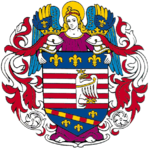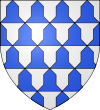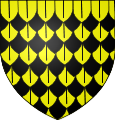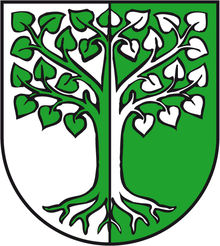- Tincture (heraldry)
-
In heraldry, tinctures are the colours used to emblazon a coat of arms. These can be divided into several categories including light tinctures called metals, dark tinctures called colours, nonstandard colours called stains, furs, and "proper". A charge tinctured proper (also sometimes termed "natural") is coloured as it would be found in nature. One of the few fundamental rules of heraldry is that metals must not be placed upon other metals and colours must not be placed upon other colours, while furs and proper can be placed upon either or both. This is referred to as the rule of tincture. Nonstandard colours called stains were introduced in the late Middle Ages, but have largely been shunned as contrary to the heraldic spirit of bold images and bright colours. A peculiar fad of the Renaissance sought to couple each tincture with an associated planet, gemstone, flower, astrological sign, etc., but this practice was soon abandoned and is now regarded as wildly divergent from the science of heraldry.[citation needed] The 19th century saw the rise of "landscape heraldry" and extensive use of charges tinctured "proper", especially in augmentations (and more often in German heraldry than English),[1] but this practice too has been deprecated as essentially unheraldic.
Contents
Basic tinctures
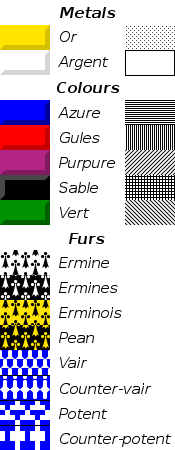
English heraldry recognises seven principal tinctures, consisting of two "metals", or light tinctures (gold and silver), and five "colours", or dark tinctures (blue, red, purple, black, and green). On the continent, however, especially in German and Nordic heraldry, purple (together with ermine, discussed below) is not used on the shield, but is reserved for the royal pavilion, the lining of some royal crowns and the caps of some of the high nobility.[2] Some continental heraldic traditions also recognise white as a colour distinct from silver. While some heraldic authors recommend a particular shade for each colour, there is only one red in heraldry, and only one green, one blue, etc. The exception to this is the late 19th century development of "natural" colours, known as stains, (see Later tinctures below) which have been largely shunned and are seldom found.
English blazon Metals Gold/Yellow Or Silver/White Argent Colours Blue Azure Red Gules Purple Purpure Black Sable Green Vert Tincture nomenclature
The names of the tinctures mainly come to us from Norman French:
- Azure is from the French azur from Arabic lazward (لازورد) from Persian lâzward ( lâzhward or lâdjward) meaning lapis lazuli.
- Sable is named after the fur of the sable marten.
- Gules may be from the French gueules, which is thought to refer to animals' red throats.
Although the English term vert is also from French, the French use the word sinople to refer to the tincture.
The patterns illustrated are occasionally used to depict arms in a monochromatic context, such as a "hatching" (sketch) or engraving.
Argent and white
Arthur Charles Fox-Davies has argued that in extremely rare circumstances, white can be a heraldic colour different from argent.[3] He bases this in part on the "white labels" used to difference the arms of members of the British Royal Family. However, it has been argued that these could be regarded as "white labels proper", thus rendering white not a heraldic tincture.[4] In Portuguese heraldry, white seems to be regarded as a tincture different from argent, as evidenced by the arms of Santiago do Cacém,[5] in which the white of the fallen Moor's clothing and the knight's horse is distinguished from the argent of the distant castle, and in the arms of the Logistical and Administrative Command of the Portuguese Air Force.
Or
Or is usually spelt with a capital letter (e.g., Gules, a fess Or) so as not to confuse it with the conjunction or.[citation needed]
Sometimes the word gold is used for Or in blazon, either to prevent repetition of the word Or, or because this substitution was the fashion in a particular period, or, more rarely, because it is the preference of an officer of arms. Regardless, Or is much more frequently used.
Sometimes Or is distinguished from yellow, as in the 1502 crest of the city of Košice: wings per fess of yellow and azure a fleur-de-lys Or.[citation needed]
Proper
Objects may also be depicted in their natural colours, described in blazons as 'proper' (though in some cases what are considered the "natural colours" are determined by convention rather than observation in the wild; for instance, a "popinjay" proper is green, not any of the huge range of colours that parrots are coloured with in nature; and dragons, though never found in nature, are when proper also green). Sometimes when "proper" alone would not give adequate information as to the appearance a colour must also then be given (e.g., a white horse proper). Proper is considered to be a tincture distinct from whatever heraldic tincture the depiction of the item or being in question would most closely approximate.
An unusual case is in the colonial arms of Algiers, in which the boulet on which the lion rests his paw is stated to be the same "proper" [au naturel] as the lion.
Some consider it bad form to depict too many charges as "proper", especially when those charges create a landscape. This experienced a vogue during the Victorian period, but came to be deprecated as being excessively difficult to draw from blazon, and somewhat contrary to the spirit of heraldry as favouring bold, clear, and unmistakable designs.
Later tinctures
Later heraldry introduced some more colours. Only three are of more than exceptional use in British heraldry: murrey (mulberry-coloured, or reddish purple), sanguine (blood-red) and tenné (an orange-tawny colour, though in continental heraldry orange is regarded as different, and South African blazons mention both "orange" and "tenné," though how these are shown is apparently interchangeable[6]). These were sometimes called stainand colours (or "stains"), as some rebatements of honour were said to be blazoned of these colours. Almost none of these rebatements are found in fact of heraldic practice, however, and in British heraldry the stains find more than exceptional use only for purposes of livery.[7]
Other colours, particularly those used in Europe, include:
- carnation (the colour of European human skin – most common in France),
- bleu celeste (also ciel or celeste – sky-blue),
- cendrée (dark grey)
The "ash colour" in the arms of Gwilt of South Wales ("Argent, a lion rampant sable, the head, paws, and half of the tail ash colour") may be the same tincture as cendrée.[8] (Sometimes charges are described as de piedra in Spanish heraldry, which literally means "of stone" and indicates a grey colour.)[9] It is important, however, to distinguish descriptions of a type of animal (such as "a horse of bay colour") followed by proper, from true heraldic tinctures.
These are rare – the seven primary tinctures are the most common ones. Rarer still are other such Continental colours as "Brunâtre," the extremely unusual occurrences of which are almost entirely limited to "details" of charges that might be blazoned as "proper," with exceptions such as the brown lion rampant in the arms of Simón Bolívar. A field Brunâtre almost never occurs, though brunatre is used more often than might be suspected in South African heraldry; the arms of the Oziel Selele Comprehensive School (Bothaville) are officially blazoned Brunatre, a torch argent inflamed or between two open rolls of parchment argent, an orle or. It is blazoned "Braun" in German heraldry. In German heraldry there are also the colours "grey", "Eisen" (iron) and "water colour," though there are unique appearances of "grey" in the heraldry of South Africa and the United States.[10] (It is unclear how "water colour" should be depicted.[11]) "Earth colour" appears not only occasionally in German heraldry, but there is at least one appearance of "earth colour" in English blazon, in the arms of the Royal Miners' Company,[12] and in the arms of Santiago de Cali, Colombia.[13] The colour "amaranth" or "columbine" was used "in a coat granted to a Bohemian knight in 1701".[14]
The arms of the Jewish Autonomous Region in Russia have a field of aquamarine, which is emblazoned more as a kind of dark green than a true aquamarine colour.
The fess on the Coat of arms of Colombia is blazoned as of the colour of platinum.
In 1997, the colour rose and the metal copper appeared in Canada, the former in the arms of Prime Minister Kim Campbell. In South African heraldry, the arms of the University of Transkei provide an example of ochre[15] and the national arms of red ochre.[16]
In the heraldry of the United States Army the shades of colours and metals are often parenthetically specified, though this is far from in keeping with normal heraldic practice. The Institute of Heraldry has also introduced the colours buff[17] (though this is often employed like a metal) and horizon blue,[18] and silver gray has appeared in the heraldry of the Army[19] and Air Force.[20] There seems to be some confusion about the colour crimson as it exists in blazon sometimes as a separate tincture and sometimes as a "definition" of the shade of gules to be employed by the artist.[21] Bronze makes appearances in the arms of the Special Troops Battalion of the 2nd Brigade, 1st Cavalry Division (there seeming to be a colour rather than a novel metal)[22] and those of Tumaco, Colombia.[23]
Furs
Furs, such as ermine, vair, and their variants, are regular patterns that represent actual fur. Any charge may be tinctured of a fur, though furs occur infrequently in German and Nordic heraldry.[24][25] In German heraldry, Kürsch (fur proper) is sometimes used, but this is seldom found elsewhere. Although the name "sable" comes from a kind of fur, the colour sable is not considered a heraldic fur.
Ermine and its variants
Main article: Ermine (heraldry)
Ermine represents the winter coat of the stoat, which is white with a black tail; many skins would be sewn together to make a luxurious garment, producing a pattern of small black spots on a white field. The conventional representation of the tails (commonly called ermine spots) is part of the tincture itself, rather than a pattern of charges, though the ermine spot is also used as a single charge (often as a mark of cadency). The ermine spot has had a wide variety of shapes over the centuries; its most usual representation has three tufts at the end (bottom), converges to a point at the root (top), and is attached by three studs.
Ermines is the reverse of ermine – a field sable semé of ermine-spots argent. It is sometimes called counter-ermine (cf. French contre-hermine and German gegen-hermelin).[26] Erminois is ermine with a field Or instead of argent, and pean is the reverse of erminois (i.e. Or spots on a field sable). Erminites is supposed to be the "same as ermine, except that the two lateral hairs of each spot are red;"[27] its existence in actual heraldic practice is doubted, however, and Arthur Charles Fox-Davies describes it as a "silly [invention] of former heraldic writers, not of former heralds."[28]
Vair and its variants
Main article: VairVair originated from alternately patterned pieces of fur from a species of squirrel with blue-grey back and white belly. The term vair was brought into Middle English from Old French, from Latin varius "variegated".[29] Basic vair consists of rows of small bell-like shapes of alternating blue and white, nowadays usually drawn with straight edges. The bells on the next row down are placed with their bottoms facing the bottoms of the bells on the row above, and so forth down. The old depictions of vair are similar in appearance to bars of azure and argent divided by alternating straight and wavy lines. (An excellent example is the lining of the cloak of Geoffrey Plantagenet as represented on his tomb.) In the past this would simply be blazoned "vair", but nowadays this is usually (though not always) blazoned vair ancient. Variations include several different arrangements of the pieces into other patterns. Vairy of [metal] and [colour] is used when a vair-like pattern is represented of any tinctures other than azure and argent. Very rarely, the individual pieces of vair are used as charges.
Potent is like vair, except using a T shape instead of a bell shape. The word potent means "crutch";[citation needed] it is thought to derive from badly-drawn vair. It is subject to all the subvarieties of vair, thus counter-potent and so on.
Other furs
German heraldry recognizes a fur called Kürsch; this is said to be drawn brown and hairy, and there are occasional references in English to "vair bellies", which may be the same thing. Plumeté is a feather-like pattern of exceptionally rare appearance which is placed in the category of furs. It can be used essentially (though not technically) as a type of patterned field.[30] "Plumetty d'aigle proper" is distinguished in at least one case, though the tincture in this case is a form of proper.[31] Pappeloné is a pattern supposed to resemble the scales on the wings of a butterfly.[32]
-

Kürsch
The rule of tincture
Main article: Rule of tinctureThe first rule of heraldry is the rule of tincture: metal must never be placed upon metal, nor colour upon colour, for the sake of contrast.
The main duty of a heraldic device is to be recognized, and the dark colours or light metals are supposed to be too difficult to distinguish if they are placed on top of other dark or light colours, particularly in poor light. Though this is the practical genesis of the rule, the rule is technical and appearance is not used in determining whether arms conform to the rule. Another reason sometimes given to justify this rule is that it was difficult to paint with enamel (colour) over enamel, or with metal over metal.[citation needed]
This rule is so closely followed that arms that violate it are called armes fausses (false arms) or armes à enquérir (arms of enquiry); any violation is presumed to be intentional, to the point that one is supposed to enquire how it came to pass. One of the most famous armes à enquérir (often said to be the only example) was the shield of the Kingdom of Jerusalem, which had gold crosses on silver. This use of metal on metal, that is to say white and gold together, is seen on the arms of the King of Jerusalem, the flag and arms of the Vatican, and the bishop's mitre in the arms of Andorra. It indicates the exceptional holy and special status of the Coat of Arms. (In the case of Jerusalem, this may also emphasize the Arab techniques gained in the Levant). An example of "colour on colour" is the arms of Albania, with its sable two-headed eagle on a gules field.
The rule of tincture has had an influence reaching far beyond heraldry. It has been applied to the design of flags, so that the flag of Saxe-Weimar-Eisenach was modified to conform to the rule.[33]
Blazon
Main article: BlazonIt was formerly customary to avoid repeating the name of any tincture. For example, Gules, on a fess Or a rose gules seeded Or would be expressed as Gules, on a fess Or a rose of the field, seeded of the second. This practice has recently been abandoned by the English College of Arms because in a complicated blazon it can cause confusion.
Likewise, instead of Vert, a fess Or between two lions passant Or, one would say, Vert, a fess between two lions passant Or (sometimes ...all Or): a tincture applies to all charges named since the last tincture mentioned. Given this, the Institute of Heraldry practice of often using the phrase "of the like" in a similar context[34][35] is out of harmony with the usual heraldic practice and completely unnecessary.
Counterchanging and countercolouring
When a charge is placed across a division line, variation, or ordinary, it may be blazoned counterchanged. However, some patterns, such as chequy, do not permit charges over them to be treated this way.
This means that the charge is divided the same way as the field it is placed upon, with the colours reversed.
A shield which is green on the upper half and silver on the lower, charged at the centre with a lion whose upper half is silver and lower half green, would be blazoned: Per fess vert and argent, a lion counterchanged.
In Scots heraldry, a charge may be blazoned as counterchanged of different colours from the field; e.g., Per fess gules and azure, a sun in splendour counterchanged Or and of the first. In English heraldry, this would be described as Per fess gules and azure, a sun in splendour per fess Or and of the first.
A situation similar to counterchanging can be seen in the arms of Brian North Lee: Sable three billets in bend Argent overlapping on a chief Vert three escallops Argent.[36] Here, the parts of the billets that overlap are shown as being sable, the tincture of the field.
Similarly to counterchanging, if multiple charges appear in two opposing divisions of the field, they may be blazoned countercoloured, meaning that the charges in a division of the field bear the colour of the opposing division of the field. An example may be seen in the Fenwick arms, blazoned originally as silver [sic, rather than the expected argent] a chief gules with six martlets countercoloured,[37] in which the chief gules bears three martlets argent and the base argent correspondingly bears three martlets gules.
Gemstone / planet blazoning
During the late medieval period and Renaissance, there was an occasional practice of blazoning tinctures by gemstones, or by references to the seven classical "planets" (including Sun and Moon), as summarized in the tables below:[38]
Tincture Planet Gemstone Or Sun Topaz Argent Moon Pearl Azure Jupiter Sapphire Gules Mars Ruby Purpure Mercury Amethyst Vert Venus Emerald Sable Saturn Diamond Stain Lunar node Gemstone Tenné Dragon's Head Jacinth Sanguine / Murrey Dragon's Tail Sardonyx Notes
- ^ Fox-Davies (1909), pp. 87-88.
- ^ Volborth (1981), p. 10.
- ^ Fox-Davies (1909), p. 70.
- ^ "Heraldry Society of Scotland". http://www.heraldry-scotland.co.uk/Forum/ShowMessage.asp?ID=2700.
- ^ "Município de Santiago do Cacém". http://www.fisicohomepage.hpg.ig.com.br/stc.htm. Retrieved 2007-06-15.
- ^ "American Heraldry Society". http://americanheraldry.org.
- ^ Fox-Davies (1909), pp. 72-73.
- ^ http://www02.so-net.ne.jp/~saitou/cgi-bin/more.cgi?input=Colours
- ^ [1][dead link]
- ^ "490th Chemical Battalion". Tioh.hqda.pentagon.mil. Archived from the original on June 22, 2008. http://web.archive.org/web/20080622115132/http://www.tioh.hqda.pentagon.mil/Chem/490ChemicalBattalion.htm. Retrieved 2009-04-16.
- ^ "Armoria ABC - Tinctures". Geocities.com. Archived from the original on 2009-07-29. http://web.archive.org/web/20090729180549/http://geocities.com/armoria/tinctures.html. Retrieved 2009-04-16.
- ^ "A Glossary Of Terms Used In Heraldry By James Parker". Heraldsnet.org. http://www.heraldsnet.org/saitou/parker/Jpglossm.htm#Mine. Retrieved 2009-04-16.
- ^ [2][dead link]
- ^ "Tinctures". Heraldica.org. http://www.heraldica.org/topics/tincturs.htm. Retrieved 2009-04-16.
- ^ [3]
- ^ "South Africa - Coat of Arms". Crwflags.com. http://www.crwflags.com/fotw/flags/za)coa.html. Retrieved 2009-04-16.
- ^ "11th Transportation Battalion Insignia Page, The Institute of Heraldry". Archived from the original on December 30, 2006. http://web.archive.org/web/20061230082906/http://www.tioh.hqda.pentagon.mil/Trans/11TransportationBattalion.htm. Retrieved 2007-08-14.
- ^ "190th Quartermaster Battalion Insignia Page". Tioh.hqda.pentagon.mil. Archived from the original on May 17, 2008. http://web.archive.org/web/20080517150124/http://www.tioh.hqda.pentagon.mil/QM/190QuartermasterBattalion.htm. Retrieved 2009-04-16.
- ^ "1st Space Battalion". Tioh.hqda.pentagon.mil. Archived from the original on July 24, 2008. http://web.archive.org/web/20080724111958/http://www.tioh.hqda.pentagon.mil/Numeric_Misc/1SpaceBattalion.htm. Retrieved 2009-04-16.
- ^ "88th ABW Emblem". Ascho.wpafb.af.mil. http://www.ascho.wpafb.af.mil/88th%20ABW%20Emblem.htm. Retrieved 2009-04-16.
- ^ "15th Ordnance Battalion". Tioh.hqda.pentagon.mil. Archived from the original on June 22, 2008. http://web.archive.org/web/20080622035410/http://www.tioh.hqda.pentagon.mil/Ord/15OrdnanceBattalion.htm. Retrieved 2009-04-16.
- ^ "American Heraldry Society forum". http://heraldrysociety.us/forum/viewtopic.php?t=541.[dead link]
- ^ "Tumaco - Colombia - Símbolos Patria chica". Orbita.starmedia.com. http://orbita.starmedia.com/tumaco2000/simbolos.html. Retrieved 2009-04-16.
- ^ Warnstedt, Christopher von (October 1970). "The Heraldic Provinces of Europe", The Coat of Arms, XI (84) 128-130.
- ^ Peter, Bernhard. "Motive und Schildbild" (in German). http://www.heraldik-leitfaden.de/Heraldik/seite44.htm. Retrieved 2009-04-25.
- ^ Fox-Davies (1909), p. 78.
- ^ "Pimbley's Dictionary of Heraldry". http://64.233.167.104/search?q=cache:kpPLTTM5mxcJ:apologetika.com/index.php%3Fmodule%3DSemantics%26func%3Ddisplay%26cid%3D10%26ltr%3DT%26search%3D%26bool%3D%26startnum%3D21+erminites&hl=en&ct=clnk&cd=107&gl=us. Retrieved 2007-08-13.
- ^ Fox-Davies (1904), p. 49.
- ^ "Vair". American Heritage Dictionary of the English Language, 4th ed. New York:Houghton Mifflin Company. 2000. http://www.bartleby.com/61/75/V0007500.html.
- ^ "The Public Register of Arms, Flags and Badges of Canada - Heraldry: Leslie Graham Cairns MILLIN". http://www.gg.ca/heraldry/pub-reg/project-pic.asp?lang=e&ProjectID=323&ProjectElementID=1106. Retrieved 2007-08-13.
- ^ "RHSC Roll of Arms - Rodunksy". http://heraldry.ca/arms/r/rodnunsky.htm. Retrieved 2008-07-04.
- ^ Fox-Davies, Arthur Charles (1909). A Complete Guide to Heraldry. New York: Dodge. p. 83.
- ^ "Grand Duchy of Saxe-Weimar-Eisenach 1813-1918 (Germany)". Flagspot.net. http://flagspot.net/flags/de-sw_hi.html. Retrieved 2009-04-16.
- ^ "SPECIAL TROOPS BATTALION, 1ST BRIGADE COMBAT TEAM, 101ST AIRBORNE DIVISION". Archived from the original on July 16, 2007. http://web.archive.org/web/20070716184226/http://www.tioh.hqda.pentagon.mil/STB/STB1BrigadeCombatTeam101AirborneDivision.htm. Retrieved 2007-08-13.
- ^ "Distinctive Unit Insignia". Tioh.hqda.pentagon.mil. 1986-07-01. Archived from the original on June 23, 2008. http://web.archive.org/web/20080623065226/http://www.tioh.hqda.pentagon.mil/Eng/229EngineerBattalion.htm. Retrieved 2009-04-16.
- ^ http://www.theheraldrysociety.com/publications/gazette/2008-Sep.pdf
- ^ http://etc.usf.edu/clipart/3200/3294/fenwick_2.htm
- ^ Fox-Davies (1909), p. 77.
- Entry "Tincture" in A Glossary of Terms Used in Heraldry by James Parker (1894). (text online)
- Entry "Tincture" in Pimbley's Dictionary of Heraldry: An Authoritative Guide to the Terminology of Heraldry by Arthur Francis Pimbley (1908) (text online)
- Precious Peers and Planetary Princes
References
- Fox-Davies, A. C. (1904). The Art of Heraldry: An Encyclopædia of Armory. (1968 edition) New York: Benjamin Blom, Inc. LCCN 68-056481
- Fox-Davies, A. C. (1909). A Complete Guide to Heraldry. (2004 edition) Whitefish, MT: Kessenger Publishing. ISBN 1417906308 LCCN 09-023803
See also
Heraldry Metals 
Colours Furs Stains Others Categories:- Heraldry
- Heraldic tinctures
Wikimedia Foundation. 2010.

